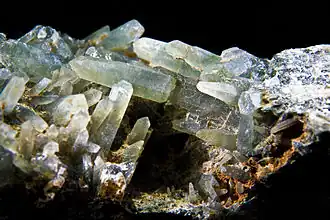Prasiolite
| Prasiolite | |
|---|---|
 | |
| General | |
| Category | Tectosilicates, quartz variety |
| Crystal system | Trigonal |
| Identification | |
| Color | Shades of green |
| Crystal habit | Hexagonal prisms |
| Cleavage | None |
| Fracture | Conchoidal[1] |
| Tenacity | Brittle[1] |
| Mohs scale hardness | 7 – lower in impure varieties[1] |
| Diaphaneity | Transparent to nearly opaque |
| Specific gravity | 2.65 |
| Refractive index | 1.544 to 1.553[2] |
| Birefringence | 0.009[3] |
| Ultraviolet fluorescence | None |
Prasiolite (also known as green quartz, green amethyst or vermarine) is a green variety of quartz, with its color typically coming from Fe2+ ions within the crystal structure.[1][4]
Natural prasiolite is exceedingly rare, having been first discovered in the early 19th century in Lower Silesia, Poland[5][6] with only a few other deposits known to exist. Natural prasiolite deposits include Płóczki Górne (Poland), Bahia (Brazil), Thunder Bay (Canada), and Farm Rooisand (Namibia).[6]
Nearly all commercially available prasiolite is artificial, either produced by heat-treating amethysts from certain locations[7] to 400-500°C,[8] or irradiating yellow-tinged quartzes.[9] Most amethyst will turn yellow or orange when heated, producing heat-treated amethysts which are often marketed as citrine, but some amethyst will turn green when treated.[8] Significant prasiolite production began in the mid-1950s with the discovery that amethysts from the Montezuma mine in Minas Gerais, Brazil turned green when heat-treated.[10]
Most prasiolite sold is used in jewellery settings, where it can substitute for far more expensive gemstones, such as peridot, tsavorite, and emerald.[11] Prasiolite used for jewelry comes from two main sources: heat-treated amethyst from the Montezuma mine, and irradiated yellow-tinged quartz from various locations throughout Brazil.[4]
Green quartz is sometimes incorrectly called green amethyst,[12] which is not an acceptable name for the material according to Federal Trade Commission Guidelines.[13] Other names for green quartz include vermarine and lime citrine.[14]
The word prasiolite literally means "leek-green stone" and is derived from Ancient Greek πράσον prason meaning "leek" and λίθος lithos meaning "stone".[15][16] The stone was given its name due to its green-colored appearance.
Natural prasiolite is a very light, translucent green. Darker green quartz is generally the result of artificial treatment,[17] with lighter-colored prasiolite often irradiated with gamma rays as an attempt to obtain deeper colors.[18]
See also
References
- ^ a b c d "Prasiolite gemstone information". www.gemdat.org. Retrieved 19 April 2018.
- ^ Lazarelli. Blue Chart Gem Identification. p. 7.
- ^ "PRASIOLITE the green variety of quartz (aka Green Amethyst)". www.galleries.com. Retrieved 19 April 2018.
- ^ a b Praszkier, Tomasz; Kenis, Piotr; Komza, Piotr. "Prasiolite from Sokołowiec area, Kaczawskie Mountains, Lower Silesia, Poland". www.spiriferminerals.com. Retrieved 2 August 2025.
- ^ Czaja, Maria; Kądziołka-Gaweł, Mariola; Konefał, Adam; Sitko, Rafał; Teper, Ewa; Mazurak, Zbigniew; Sachanbiński, Michał (2017). "The Mössbauer spectra of prasiolite and amethyst crystals from Poland". Physics and Chemistry of Minerals. 44: 1. doi:10.1007/s00269-016-0864-z. ISSN 1432-2021.
- ^ a b Platonov, Alexej N.; Szuszkiewicz, Adam (2015). "Green to blue-green quartz from Rakowice Wielkie (Sudetes, south-western Poland) – a re-examination of prasiolite-related colour varieties of quartz". Mineralogia. 46 (1/2): 19–20. doi:10.1515/mipo-2016-0004.
- ^ Akhavan, Amir C. (2011). "Prasiolite". www.quartzpage.de. Retrieved 2 August 2025.
- ^ a b Henn, Ulrich; Schultz-Güttler, Rainer (2012). "Review of some current coloured quartz varieties" (PDF). The Journal of Gemmology. 33 (1–4): 34. doi:10.15506/JoG.2012.33.1.29. ISSN 1355-4565.
- ^ "Prasiolite". www.edelsteine.at. Retrieved 2 August 2025.
- ^ Fryer, C. W. (1996). "QUARTZ, Single-Crystal Green" (PDF). Gems & Gemology. 32 (3). Gemological Institute of America: 210–211. ISSN 0016-626X.
- ^ Sedawie, Ross (2025) [First Published 2022]. "Prasiolite Gemstone: Properties, Meanings, Value & More". www.gemrockauctions.com. Retrieved 2 August 2025.
- ^ "Green Amethyst". GemSelect. Retrieved 10 December 2012.
- ^ 16 CFR 23.26
- ^ "Green Quartz Meaning and Properties". firemountaingems.com. n.d. Retrieved 21 October 2021.
- ^ Bailey, Dorothy; Bailey, Kenneth C. (1929). An Etymological Dictionary of Chemistry and Mineralogy. E. Arnold & Company. p. 222.
- ^ "Prasiolite". www.langantiques.com. Retrieved 2 August 2025.
- ^ Gems and Gemstones: Timeless Natural Beauty of the Mineral World By Lance Grande, Allison Augustyn, p.91
- ^ Nunes, Eduardo H.M.; Lameiras, Fernando S.; Houmard, Manuel; Vasconcelos, Wander L. (2013). "Spectroscopic study of natural quartz samples". Radiation Physics and Chemistry. 90: 80. doi:10.1016/j.radphyschem.2013.05.003. ISSN 1879-0895.
External links